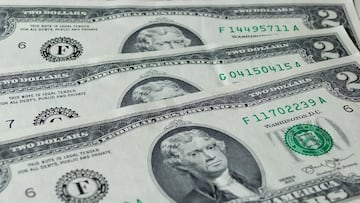How to spot 2-dollar bills that could be worth up to $20,000
Seeing a $2 bill is rare but there are actually millions still in circulation. A select few are worth much more than the face value.

The $2 bill has a strange history in the United States. The bills are rarely seen because businesses’ banking policies do not rely on $2 bills. Nevertheless they remain legal tender in the US and a select few can be worth an eye-watering sum of money.
According to MarketWatch some uncirculated $2 bills can be worth as much as $20,000. Their value also depends on a few factors, such as serial numbers, when the bills were printed, and their condition.
Here is what you should be on the lookout for...
Serial number
The serial number is printed on the left and right sides of the front of the note, usually with a letter beginning the string of digits. It is randomly assigned but it is one of the main factors that can increase a bill’s value.
“A serial number ‘1′ for a 1976 $2 bill would be worth $20,000 or more,” Dustin Johnston, vice president of Heritage Auctions, told MarketWatch.
Other high-value serial numbers include so-called “ladder” or “solid” numbers. Solid serial numbers are codes that have the same digit, such as 88888888888. On the other hand, a ladder number features digits listed in ascending order, such as 12345678910. Anything distinctive could be lucrative.
Age
As is the case which a lot of collecting, much of a bill’s value is in its age. For example, anything more than 100 years old could be worth much more than the face value.
However, rarity is not solely determined by the year of printing. The number of banknotes printed in a given year and the number still in circulation can also affect their rarity. Check out online auction sites to see which years are the most valuable.
Condition
Another important factor to consider is the condition of the bill. Collectors will be interested in the bill having been kept in good condition and will be willing to pay more for a bill that does not have as many wrinkles, rips, or discoloration. For the big-money bills, anything other that mint condition will severely decrease the value.
How much is a $2 bill worth?
According to the US First Exchange site, there are four types of value to consider when attempting to price up a bill: catalogue value, purchase price, public or retail value and wholesale value.
List value is the average price for which most people would sell a coin or note. The purchase price is what a dealer would be willing to pay. Retail value is the price that a specific dealer would be willing to sell you a coin or note for. Wholesale value is the price that dealers use when trading with each other.
The value of a coin or banknote essentially determines its catalogue value based on three main factors: rarity, condition/grade, and market conditions, i.e., demand. The combination of these three factors determines whether a coin or banknote is worth more or less money.
If you have a $2 bill or other coins worth more than their face value, you can go to a pawn shop to have them valued. You can also look for specialized Facebook groups, check eBay, or the Professional Coin Grading Service (PCGS) website.
Related stories
Get your game on! Whether you’re into NFL touchdowns, NBA buzzer-beaters, world-class soccer goals, or MLB home runs, our app has it all.
Dive into live coverage, expert insights, breaking news, exclusive videos, and more – plus, stay updated on the latest in current affairs and entertainment. Download now for all-access coverage, right at your fingertips – anytime, anywhere.



Complete your personal details to comment